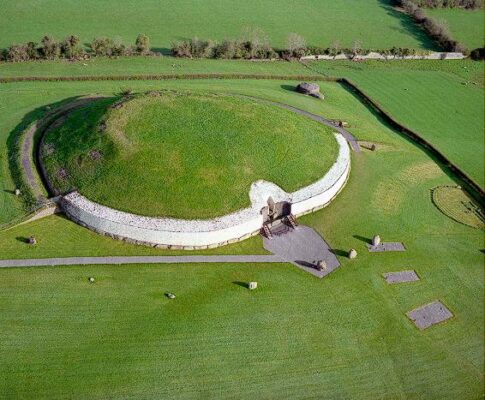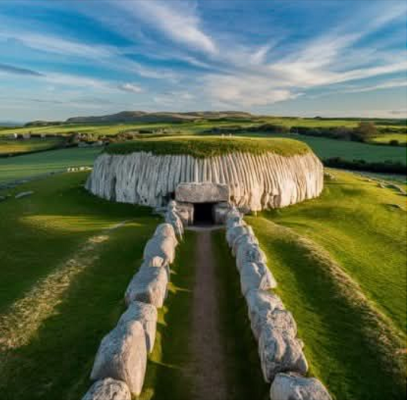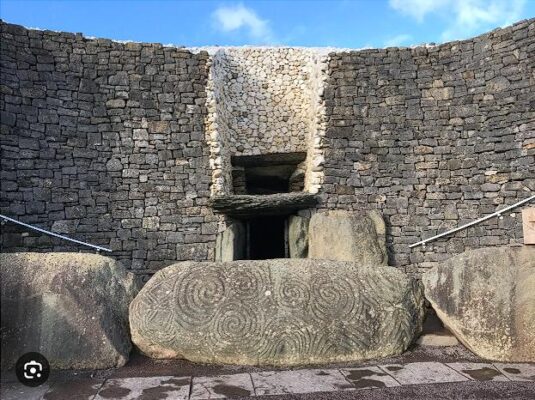Introduction to Newgrange
Newgrange, located in County Meath, Ireland, is one of the most significant prehistoric monuments in Europe. Dating back to approximately 3200 BC, it predates both Stonehenge and the Egyptian pyramids, making it one of the world’s oldest known structures. This ancient passage tomb, part of the Brú na Bóinne complex, is a marvel of engineering and astronomical precision, offering invaluable insights into the lives and beliefs of Neolithic people.
Location and Historical Significance
Newgrange is situated within the Brú na Bóinne UNESCO World Heritage Site, which also includes the passage tombs of Knowth and Dowth. These structures are remnants of a sophisticated prehistoric civilization that once thrived in Ireland. Newgrange’s intricate design and alignment with celestial events highlight the advanced knowledge of its builders.
Discovery and Excavation
Although Newgrange was known locally for centuries, it wasn’t until the 17th century that scholars began to take an interest in its origins. Archaeological excavations in the 1960s led to a greater understanding of its purpose and construction, uncovering remarkable artifacts and revealing its precise alignment with the winter solstice.

The Architecture of Newgrange
Newgrange is a circular mound measuring about 85 meters (279 feet) in diameter and 13 meters (43 feet) in height. It consists of a passageway leading to a central chamber, surrounded by a kerb of large stones, many of which are adorned with intricate carvings.
The Passage Tomb Structure
The interior of Newgrange features a long passageway, about 19 meters (62 feet) in length, leading to a cruciform (cross-shaped) chamber. The chamber is roofed using a corbelled vault technique, which has kept it waterproof for over 5,000 years. Inside, massive stones line the passage, some decorated with swirling patterns and geometric designs.
Megalithic Art and Symbolism
One of the most fascinating aspects of Newgrange is its elaborate megalithic art. The entrance stone, decorated with intricate spirals, is one of the finest examples of prehistoric carvings in Europe. The motifs found within Newgrange are believed to represent solar and lunar cycles, reinforcing the tomb’s connection to celestial movements.

The Winter Solstice Phenomenon
Perhaps the most extraordinary feature of Newgrange is its precise alignment with the winter solstice sunrise. Each year, for a few days around December 21st, sunlight enters through a specially designed “roof box” above the entrance, illuminating the inner chamber in a dramatic display.
Astronomical Precision
The builders of Newgrange demonstrated remarkable knowledge of astronomy. The roof box was designed to allow the first rays of the winter solstice sun to penetrate the tomb, lighting up the central chamber for approximately 17 minutes. This suggests that the site played an essential role in rituals related to the changing seasons.
Rituals and Spiritual Significance
The solstice illumination likely held deep spiritual significance for the Neolithic people who constructed Newgrange. Many scholars believe it was used for ceremonies marking renewal, fertility, and the cycle of life and death. The alignment underscores the strong connection between early human societies and the cosmos.
Theories About Newgrange’s Purpose
Newgrange has long been the subject of debate among historians and archaeologists. While its primary function appears to have been as a tomb, other theories suggest it may have had additional purposes.
Burial Site for Elites
Excavations have uncovered cremated human remains, indicating that Newgrange was used as a burial site. Given its monumental scale, it is likely that only high-status individuals were interred there, possibly tribal leaders or revered spiritual figures.
Temple of the Sun
Another theory proposes that Newgrange functioned as a temple dedicated to the sun. Its alignment with the winter solstice suggests it may have been a sacred site where ceremonies honoring celestial deities were performed. This aligns with similar sun-worship practices found in other ancient cultures.

Newgrange in Modern Times
Today, Newgrange is one of Ireland’s most visited archaeological sites, attracting thousands of tourists and researchers each year. Its recognition as a UNESCO World Heritage Site ensures its preservation for future generations.
Visitor Experience and Tours
Visitors to Newgrange can explore the site through guided tours, which provide insights into its history, architecture, and significance. The nearby Brú na Bóinne Visitor Centre offers exhibitions and interactive displays that enhance the visitor experience.
Influence on Archaeology and Science
Newgrange continues to influence the fields of archaeology and astronomy. Its sophisticated design challenges assumptions about the capabilities of prehistoric societies, demonstrating their advanced understanding of engineering and celestial mechanics.
Conclusion
Newgrange is more than just a tomb; it is a testament to the ingenuity and spiritual depth of its builders. As one of the world’s oldest and most significant megalithic structures, it offers a glimpse into the beliefs and astronomical knowledge of Neolithic societies. Whether viewed as a burial site, a solar temple, or a monument to ancient wisdom, Newgrange remains a symbol of Ireland’s rich prehistoric heritage, inspiring awe and curiosity in all who visit.

CÁC TIN KHÁC
Mary Walton: The Forgotten Inventor Who Helped Clean Up America’s Cities
Tomb of Queen Nefertari in the Valley of the Queens, Egypt
Discover the Hypostyle Hall of the Temple of Hathor at Dendera
Venus de Losange: Unveiling the Mystery of a 20,000-Year-Old Paleolithic Icon